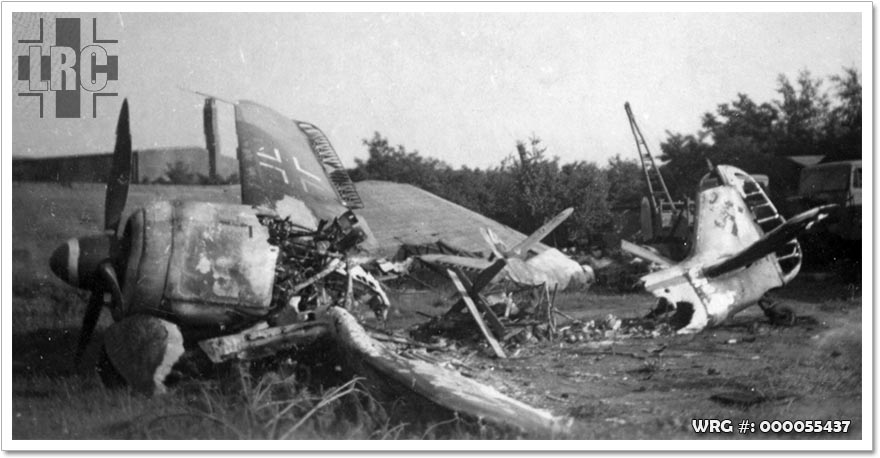Focke Wulf Fw 190
Operational History:
Operation Citadel to the Dnieper
The Oberkommando der Wehrmacht (OKW or German High Command) chose to eliminate the bulge of Kursk. Unternehmen
Zitadelle (Operation Citadel), planned for the summer, 1943, would be the Fw 190's first major battle in
number. By June 1943 the Fw 190 was to reach peak strength. II./JG 54, the main operator, operated 196
fighters before Zitadelle. However, some of this total included Bf 109s still on strength. I./54, I., III.,
and IV./ Jagdgeschwader 51 (JG 51) mustered 186 Fw 190s (most of the fighter force in this region operated
the Fw 190), 88 of them serviceable. The Fw 190 force was assigned to the northern sector near Orel,
supporting the German Ninth Army.
In the early morning of 5 July 1943, the opening day of the offensive, the Fw 190s won air superiority over the
northern sector. Soviet aviation was held in reserve and its units fed in piecemeal, whereas 1 Fliegerdivision
had made an all out effort. The Soviet 16th Air Army (16VA) was permitted to engage only one-third of its
fighter force. The German numerical superiority managed to deliver a severe defeat on Soviet aviation on
this date. The Fw 190s had the upper hand and shot down scores of Soviet fighter aircraft allowing the German
strike aircraft to attack Red Army positions at will. Within a space of a few hours, 50 Soviet aircraft had
been shot down. For just 29 casualties, 18 of them destroyed and seven Fw 190s shot down in combat,
1st Fliegerdivision filed claims for 165 victories. The division had over claimed, but Soviet losses were
around 100. The Fw 190's performance as a low level air superiority fighter was evident and it reflected
the German superiority in the air on that date.
On 6 July the Fw 190 again proved its worth at low altitude. Soviet fighters providing close escort for slow
bombers enabled the Fw 190s of JG 51 and JG 54 to attack Soviet formations at will. Fw 190s claimed a ratio in
favour of 60:1 on this date; losing two fighters shot down and two damaged while claiming 121 enemy aircraft
destroyed. The situation called for a change in Soviet air tactics. Soviet fighters on airfields were placed
on alert should larger German formations appear and fighters were now permitted to conduct fighter sweeps in
small formations of four to six aircraft. These changes had limited influence of the air battle and not the
significant results claimed by Soviet histories. Soviet aviation would still sustain heavy losses. JG 51
and 54 had inflicted heavy damage, the three regiments of 1 DIAD (1st Guards Fighter Division) could field
only 26 fighters between them. The 6th IAK (Air Corps) could muster just 48 fighters.
Two main reasons resulted in these loss rates; Soviet pilots were still limited to close escort duty and were
not allowed to pursue aircraft into airspace guarded by other Soviet units which restricted their freedom, and
when the experience of the German pilots is added, the result was damaging. On 7 July, the 16th Air Army lost
30 aircraft for three Fw 190s destroyed and three crash-landed in German-held territory. On 8 July, the
Fw 190 units claimed 74 of the 81 Soviet aircraft claimed destroyed on that date. Actual Soviet losses were
43.
With the German armies now exhausted, the Fw 190 units were asked to perform Jabo, or fighter-bomber missions.
JG 54 flew missions in this capacity. Now performing dual purposes, the Fw 190 achieved significant recognition
as a rugged aircraft. On 12 July 1943, the 16VA was almost driven from the skies by Fw 190 Geschwader. The air
battle had been decisively won by the 1st Fliegerdivision, thanks largely to the Fw 190. However, the ground
battle was lost. On 13 July the Soviets launched Operation Kutuzov. The offensive threatened to cut off
the entire German Ninth and Second Panzer Army. Luftwaffe resistance was vital to slowing down Soviet
advances. On several days, the Luftwaffe achieved numerical superiority. The 15th Air Army could not
prevent the Fw 190 units gaining air superiority which allowed Ju 87 units to help the Army to restrict
the Red Army's break through to the first German defence line on the first day. But the overall
situation could not be sustained, as the Soviet ground forces had made several advances further north.
Between 1 and 31 July 1943 JG 51 claimed 800 victories against 77 Fw 190s (50 destroyed). JG 54
claimed 450 for the same period for 34 Fw 190s (24 destroyed). Even though it is probable that
between 25 and 33 percent of these claims were exaggerations, the statistics confirm the qualitative
superiority of tactical air units in combat. More accurate data suggests JG 51s losses were
55 Fw 190s destroyed and 31 damaged. The introduction of the Fw 190 to the front had proven wise.
The armament of the Fw 190 was something that was needed by German fighter units. The IL-2
Shturmoviks were becoming available in increasing numbers, and the Fw 190 was an ideal counter
to the Soviet aircraft.

Sources:
Gunston, Bill - The Encyclodepia of the Worlds Combat aircraft, 1976, Chartwell Books, Inc., New York
Brown, Eric, Captain - Wings of the Luftwaffe , 1979, Airlife Publishing Ltd., Shrewsbury
, 1979, Airlife Publishing Ltd., Shrewsbury
Gunston, Bill & Wood, Tony - Hitler's Luftwaffe , 1977, Salamander
Books Ltd., London
, 1977, Salamander
Books Ltd., London
Donald, David - The Complete Encyclopedia Of World Aircraft, 1997, Brown Packaging Books Ltd., London
Wikipedia - Fw 190
Gunston, Bill - The Encyclodepia of the Worlds Combat aircraft, 1976, Chartwell Books, Inc., New York
Brown, Eric, Captain - Wings of the Luftwaffe
Gunston, Bill & Wood, Tony - Hitler's Luftwaffe
Donald, David - The Complete Encyclopedia Of World Aircraft, 1997, Brown Packaging Books Ltd., London
Wikipedia - Fw 190






